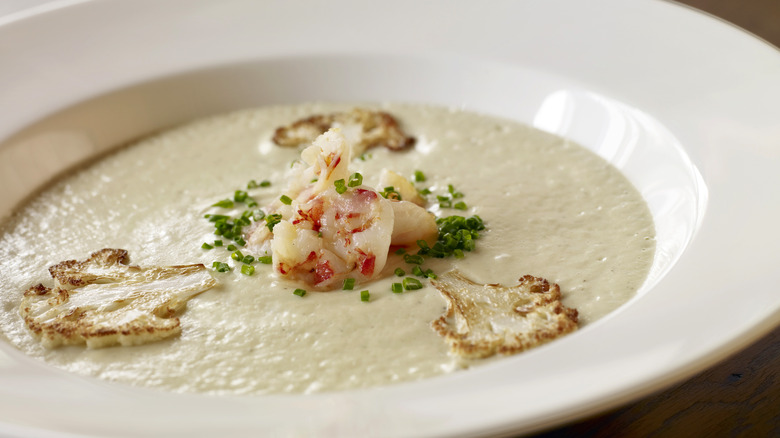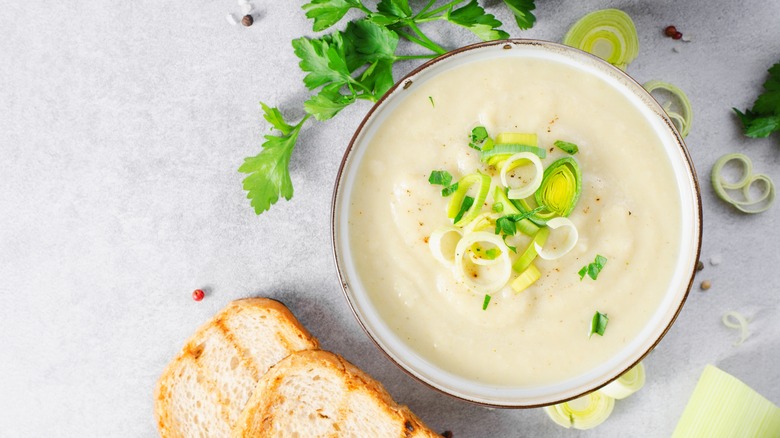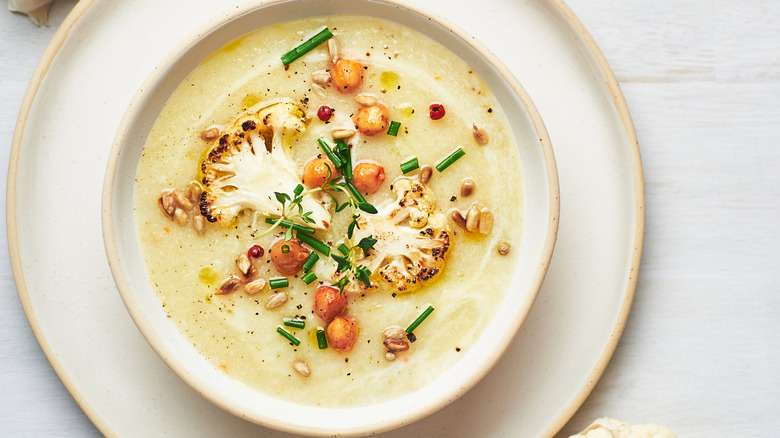The Reason You Don't Need Cream For A Luscious Cauliflower Soup
That first spoonful of cauliflower soup can trick your tastebuds into believing they are enjoying real cream. But with this dairy-free option, that creamy texture is easy to achieve.
While cauliflower is a cruciferous vegetable, the food has a low insoluble fiber content. This fiber can easily transform it into a smooth purée. Although not liquefied, the creamy, thicker consistency has weight and helps you feel fuller for longer. Even though paste might not be the most appetizing term, it has a denseness that adds a heft when combined with other liquids, even without cream.
The puréed, cooked vegetable acts as the base to create a creamy, thick cauliflower soup. Depending on personal taste, the soup can be served with a denser consistency or thinned with broth or water. As long as the blend is smooth, it can mimic the luscious qualities of a cream or coconut milk. The vegetable solution can be a better choice for those who prefer to avoid dairy or are vegan.
Simple ways to boost cauliflower soup's flavor
For the cooks who ditched the cream and opted for cauliflower purée as a soup base, the question remains: Can the cauliflower bring as much flavor as cream? It can be even more in many cases since the dairy component can overpower other flavors in the soup.
When making a cauliflower purée, cooking the vegetable is where the flavor begins. Roasting the cauliflower brings out a nutty note. Consider adding some herbs, garlic, or even just salt and pepper. Since cauliflower easily melds with other flavors, it is imperative to consider the savory, salty, or other desired flavors when cooking starts. It is better to season the cauliflower first instead of trying to fix it on the back end.
The slow-roasting cooking method can even deliver a hint of sweetness. As the creamy white cauliflower turns a warm, golden brown, the visual showcases flavor waiting to be blended into a creamy, tantalizing purée.
While the cauliflower can be steamed, that method does not develop as much flavor. Frying, which can create a tasty snack, can add an unctuous quality that could be unpleasant in a soup. It can be better to stick with roasting for optimum flavor enhancement.
Simple ways to upgrade a cauliflower soup
While a great cauliflower soup may not need a heaping pour of cream or a bevy of additions, a few simple additions can make the dish even more flavorful. For example, using roasted cauliflower as a main ingredient in the recipe, consider setting aside a few pieces as a garnish for the soup. Carefully centered in the bowl, the visual adds to the appeal, and the ingredient brings a contrast in texture.
Second, a little oil can boost the flavor of the dish. Using a drizzle of chive oil, citrus oil, or even extra virgin olive oil can offer flavor parallels to other ingredients in the soup. One note of caution: Use these ingredients sparingly since no one wants to earn that creamy soup into an oil spill.
Lastly, a simple herb garnish brings a zesty note in flavor and appearance. The pop of green is a feast for the eyes, and the brightness can be the punch of acid to heighten the eating experience. But, similar to the oil component, a little can go a long way.
As many cooks appreciate, the best recipes are more than just a bite eaten with the eyes closed. Presenting the dish in an enticing way enhances the flavor. The garnishes might be as important as building the flavor before it hits the soup bowl.


